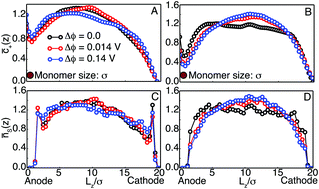Structure and proton conduction in sulfonated poly(ether ether ketone) semi-permeable membranes: a multi-scale computational approach
Abstract
The design of polymeric membranes for proton or ionic exchange highly depends on the fundamental understanding of the physical and molecular mechanisms that control the formation of the conduction channels. There is an inherent relation between the dynamical structure of the polymeric membrane and the electrostatic forces that drive membrane segregation and proton transport. Here, we used a multi-scale computational approach to analyze the morphology of sulfonated poly(ether ether ketone) membranes at the mesoscale. A self-consistent description of the electrostatic phenomenon was adopted, where discrete polymer chains and a continuum proton field were embedded in a continuum fluid. Brownian dynamics was used for the evolution of the suspended polymer molecules, while a convection–diffusion transport equation, including the Nernst–Planck diffusion mechanism, accounted for the dynamics of the proton concentration field. We varied the polymer concentration, the degree of sulfonation and the level of confinement to find relationships between membrane structure and proton conduction. Our results indicate that the reduced mobility of polymer chains, at concentrations above overlap, and a moderate degree of sulfonation – i.e., 30% – are essential elements for membrane segregation and proton domain connectivity. These conditions also ensure that the membrane structure is not affected by size or by potential gradients. Importantly, our analysis shows that membrane conductivity and current are linearly dependent on polymer concentration and quadratically dependent on the degree of sulfonation. We found that the optimal polymeric membrane design requires a polymer concentration above overlap and a degree of sulfonation around 50%. These conditions promote a dynamical membrane morphology with a constant density of proton channels. Our results and measurements agree with previous experimental works, thereby validating our model and observations.



 Please wait while we load your content...
Please wait while we load your content...